Introduction: A Star in the Venetian Firmament
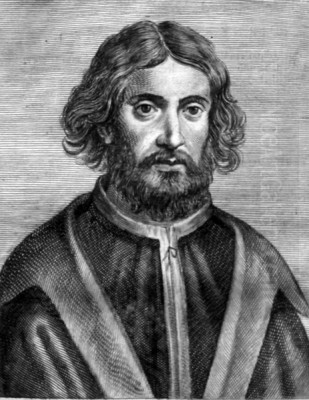
Jacopo Negretti, known to posterity as Palma Vecchio ("Palma the Elder"), stands as a significant figure in the glittering constellation of artists that defined the Venetian School during the Italian High Renaissance. Born around 1480 near the town of Serina Alta, close to Bergamo in Lombardy, his artistic destiny unfolded primarily in the vibrant, water-laced city of Venice. He arrived during a period of extraordinary artistic ferment and quickly established himself as a painter of considerable talent and sensitivity, contributing significantly to the visual language of his time before his relatively early death in 1528.
Palma Vecchio's art is celebrated for its rich, luminous color, its gentle handling of light and shadow (sfumato), and its creation of harmonious, often idyllic, compositions. He excelled in popular genres of the day, particularly the sacra conversazione (holy conversation), depicting serene gatherings of saints around the Madonna and Child, often set within lush landscapes. He is perhaps equally famous for his portrayals of idealized female beauty, capturing the sensuous allure and opulent fashion of Venetian women, whether in mythological guises, as saints, or in straightforward portraiture. Though sometimes seen as operating in the shadow of his slightly younger and longer-lived contemporary, Titian, Palma Vecchio carved out a distinct and influential niche, blending influences from masters like Giorgione and Giovanni Bellini into a style uniquely his own.
From Bergamo to Venice: The Formative Years
Jacopo Negretti's origins lie not in Venice itself, but in the Lombard region, specifically Serina Alta near Bergamo. This area, while under Venetian political control, had its own artistic traditions. However, like many ambitious artists from the Venetian terraferma (mainland territories), the lure of the capital city, the center of artistic patronage and innovation, proved irresistible. The exact date of his move to Venice is uncertain, but it likely occurred in the early years of the 16th century, perhaps around 1500 or shortly thereafter.
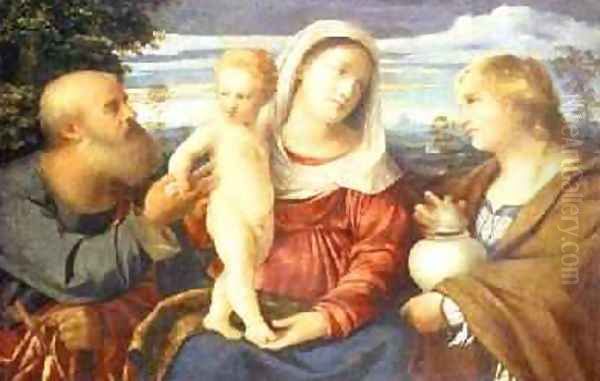
He entered an artistic environment dominated by the aging but still influential Giovanni Bellini, the undisputed master who had shaped Venetian painting for decades. Bellini's workshop was a training ground for many talents. While direct documentation of Palma's training is lacking, his early works show an affinity with the Bellini tradition, particularly in the clarity of form and the gentle piety of his religious figures. He would also have encountered the narrative richness of Vittore Carpaccio and the burgeoning talents of Giorgione and Titian, who were themselves absorbing lessons from Bellini while forging revolutionary new paths. This dynamic atmosphere provided the fertile ground in which Palma Vecchio's own artistic identity would take root and blossom.
Artistic Development and Key Influences
Palma Vecchio's artistic journey was shaped by the powerful currents swirling through Venetian art in the early 16th century. He proved adept at absorbing and synthesizing the innovations of his peers and predecessors, creating a style that was both contemporary and personal. Two figures, in particular, cast long shadows over his development: Giorgione and Titian.
The Giorgionesque Legacy: Mood and Mystery
Giorgio da Castelfranco, known as Giorgione, was a meteoric talent whose enigmatic paintings revolutionized Venetian art before his early death (likely from plague) around 1510. Palma Vecchio clearly fell under his spell. Giorgione's emphasis on mood, his use of soft, atmospheric light (sfumato) to blend figures seamlessly with evocative landscapes, and his preference for poetic, often ambiguous subjects resonated deeply with Palma.
This influence is most apparent in Palma's sacra conversazione paintings and mythological scenes. He adopted Giorgione's technique of building forms through color and tone rather than sharp outlines, creating a sense of warmth and intimacy. The pastoral settings, the dreamy expressions of his figures, and the overall sense of tranquil harmony in many of Palma's works owe a significant debt to Giorgione. Artists like Sebastiano del Piombo also followed Giorgione's path, demonstrating the profound impact of his short career. Palma, however, adapted these elements to his own temperament, often bringing a greater robustness and clarity to his figures than seen in Giorgione's more elusive works.
In Titian's Orbit: Color and Monumentality
Tiziano Vecellio, or Titian, emerged alongside Giorgione but went on to dominate Venetian painting for over six decades. Palma Vecchio's relationship with Titian appears to have been one of mutual awareness and, likely, influence, though perhaps tinged with rivalry. Palma certainly absorbed aspects of Titian's burgeoning style, particularly his increasingly bold use of color, his dynamic compositions, and the growing monumentality of his figures.
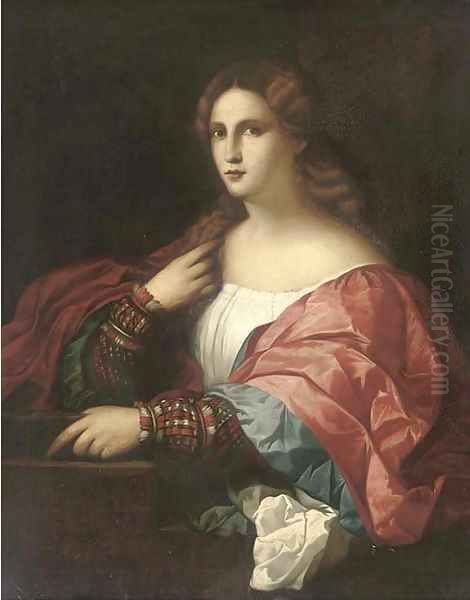
Some of Palma's works from the 1510s and 1520s show a Titianesque richness of pigment and a more assertive physical presence in the figures. However, Palma generally retained a softer, more lyrical quality compared to Titian's often dramatic intensity. While Titian pushed towards greater psychological depth and dynamic action, Palma often favored a more serene and idealized vision. He never fully abandoned the gentler, more pastoral sensibility inherited from the Giorgionesque tradition, creating a distinct stylistic space alongside his formidable contemporary. Other artists navigating this vibrant scene included Paris Bordone, who often combined Titian's richness with a distinct elegance.
The Enduring Influence of Bellini
While Giorgione and Titian represented the cutting edge, the foundational influence of Giovanni Bellini should not be overlooked. Bellini established the importance of color and light in Venetian art and perfected the sacra conversazione format set in a landscape, a genre Palma would make his own. Bellini's emphasis on harmonious composition and serene piety provided a bedrock upon which Palma, Giorgione, and Titian all built their innovations. Even as Palma embraced the newer trends of sfumato and richer palettes, the underlying structure and devotional sincerity in his religious works often echo the elder master's legacy. The broader Bellini family, including Gentile Bellini, had also contributed significantly to establishing Venice's artistic reputation.
Hallmarks of Palma Vecchio's Style
Palma Vecchio forged a distinctive artistic identity characterized by several key features that made his work highly sought after by Venetian patrons. His style represents a harmonious blend of High Renaissance ideals with a specifically Venetian sensibility.
Luminous Color and Soft Light
Like his Venetian contemporaries, Palma Vecchio was a master of colorito, the practice of prioritizing color and light to build form and create atmosphere. His palette is typically rich and warm, featuring glowing reds, deep blues, vibrant greens, and golden yellows. He applied paint in layered glazes, achieving a luminosity and depth that makes his surfaces shimmer.
Crucially, he employed a delicate sfumato, softening contours and allowing figures to merge gently with their surroundings. This technique, learned from Giorgione and practiced alongside Titian, contributes to the harmonious, often dreamlike quality of his paintings. Light in Palma's work is rarely harsh; instead, it tends to be diffused and gentle, modeling forms softly and enhancing the sensuous appeal of textures like skin, hair, and rich fabrics.
Mastery of the Sacra Conversazione
Palma Vecchio excelled in the genre of the sacra conversazione, or "holy conversation." These paintings depict the Virgin and Child surrounded by various saints, not usually interacting in a narrative sense, but sharing a common sacred space, often an idealized landscape. Palma produced numerous variations on this theme, demonstrating his skill in creating balanced and serene compositions.
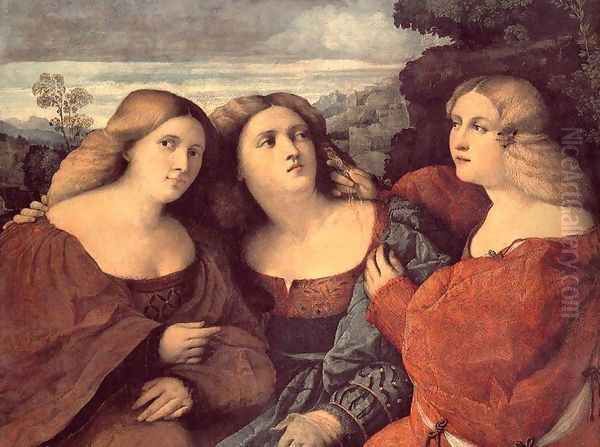
His figures are typically arranged in stable, often horizontal or pyramidal groupings. They possess a calm dignity and often seem lost in contemplation. The landscapes are lush and idyllic, contributing to the overall sense of peace and divine harmony. These works were popular for private devotion and for altarpieces in smaller chapels, offering viewers a vision of heavenly tranquility. A prime example is the altarpiece for the church of Santa Maria Formosa in Venice. Another significant work is the large altarpiece featuring St. Peter Enthroned with Six Saints, now housed in the Gallerie dell'Accademia, Venice.
Idealized Female Beauty: The Venetian Blonde
One of Palma Vecchio's most enduring legacies is his depiction of idealized female beauty, often characterized by voluptuous forms, creamy skin, and abundant, flowing blonde (often reddish-blonde) hair. These figures, whether portraying saints like Catherine or Mary Magdalene, mythological figures like Venus, or contemporary Venetian women in allegorical or portrait contexts, became almost a trademark.
These depictions tapped into a specific Venetian aesthetic ideal of the time, celebrating sensuous beauty and luxurious appearance. Works like La Bella (Thyssen-Bornemisza Museum, Madrid) or the famous The Three Sisters (Gemäldegalerie Alte Meister, Dresden) exemplify this aspect of his art. He rendered the textures of hair, flesh, and rich fabrics – velvets, silks, brocades – with palpable skill, enhancing the tactile and visual appeal of his subjects. His Lucretia, known through versions in Vienna and Rome (Borghese Gallery), combines this idealized beauty with narrative drama.
Mythological and Pastoral Themes
Reflecting the influence of Giorgione and the tastes of humanist patrons, Palma Vecchio also engaged with mythological and pastoral subjects. These paintings allowed for a greater exploration of the idealized nude and the depiction of idyllic landscapes, often imbued with a gentle melancholy or poetic feeling.
His Venus and Cupid (Fitzwilliam Museum, Cambridge) is a fine example, showcasing his ability to render the female form with sensuous grace within a harmonious natural setting. The painting Jacob and Rachel (Gemäldegalerie Alte Meister, Dresden) transforms a biblical story into a serene pastoral encounter, emphasizing the landscape and the gentle interaction between the figures, very much in the Giorgionesque spirit. These works highlight Palma's versatility beyond purely religious commissions.
Sensitive Portraiture
While best known for his religious and mythological works, and his idealized female types, Palma Vecchio also produced sensitive portraits. These often depict unnamed sitters, sometimes identified by attributes (like the Portrait of a Poet in the National Gallery, London) or simply presented as compelling individuals.

His portraits share the characteristics of his broader style: rich color, soft modeling, and an emphasis on capturing the texture of fabrics and flesh. While perhaps not possessing the penetrating psychological depth found in the greatest portraits by Titian or Lorenzo Lotto, Palma's portraits convey a sense of presence and individual character, often imbued with a gentle dignity. The Portrait of a Venetian Merchant (location sometimes debated, possibly Vienna or Uffizi) showcases his skill in this genre, capturing the assured bearing of a member of Venice's prosperous class.
Major Works and Their Homes
Palma Vecchio was a prolific artist, and his works are found in major museums and churches across the world. While a comprehensive list is extensive, some of his most representative and celebrated paintings include:
Gallerie dell'Accademia, Venice: This museum holds several key works, including the monumental St. Peter Enthroned with Saints (originally for the church of San Pietro Martire, Zerman) and a beautiful Sacra Conversazione.
Santa Maria Formosa, Venice: Home to the important altarpiece Saint Barbara with Saints Anthony Abbot, Vincent Ferrer, Sebastian, and John the Baptist (sometimes referred to by its central figure, St. Barbara, or as a Sacra Conversazione). This work is renowned for its majestic central figure and rich coloration.
Gemäldegalerie Alte Meister, Dresden: Possesses some of Palma's most famous works, including The Three Sisters (a celebrated example of his idealized female types) and the pastoral Jacob and Rachel.
Kunsthistorisches Museum, Vienna: Holds a significant collection, including versions of Lucretia, several Sacra Conversazione compositions, and portraits, showcasing the breadth of his work.
National Gallery, London: Features works like A Blonde Woman (another iconic female type) and the thoughtful Portrait of a Poet.
Louvre Museum, Paris: Houses examples such as The Holy Family with the Infant Saint John the Baptist, Saint Catherine of Alexandria and a Donor, demonstrating his skill in complex group compositions.
Uffizi Gallery, Florence: Contains notable works, including portraits and religious scenes attributed to Palma, reflecting his reputation throughout Italy.
Fitzwilliam Museum, Cambridge: Home to the sensuous Venus and Cupid.
Thyssen-Bornemisza Museum, Madrid: Holds the iconic portrait known as La Bella.
Borghese Gallery, Rome: Features another version of the dramatic Lucretia.
Numerous other museums and private collections hold works by Palma Vecchio, testament to his productivity and the high esteem in which his art was held. His paintings consistently demonstrate the hallmarks of his style: harmonious composition, rich Venetian color, soft sfumato, and often, idealized, sensuous figures.
Workshop, Family, and Collaborators
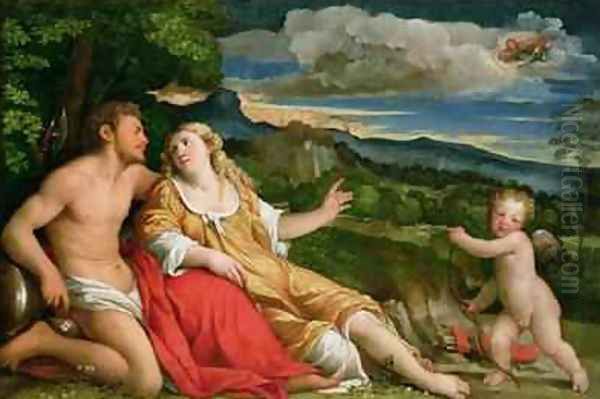
Like most successful Renaissance artists, Palma Vecchio likely maintained an active workshop in Venice to help meet the demand for his paintings. Assistants would have helped with preparing panels and canvases, grinding pigments, painting backgrounds, and perhaps even executing replicas or variations of popular compositions under the master's supervision.
His most significant familial connection in the art world was his great-nephew, Jacopo Palma il Giovane ("Palma the Younger," c. 1548/50–1628). To avoid confusion between the two artists, the elder Jacopo Negretti became known as Palma Vecchio ("the Elder"). Palma Giovane became a highly successful painter in his own right, carrying the Venetian tradition into the late 16th and early 17th centuries, though his style evolved towards Mannerism and the influence of Tintoretto and Veronese.
Palma Vecchio also had notable students and followers. The most important was probably Bonifazio de' Pitati, often called Bonifazio Veronese (though not related to Paolo Veronese). Bonifazio closely absorbed Palma's style, particularly his handling of sacra conversazione and pastoral themes, and ran a large, productive workshop himself, further disseminating Palma's influence. Bonifazio's work, in turn, is sometimes seen as influencing the early development of later Venetian masters.
Later Career and Untimely Death
Palma Vecchio remained active and highly regarded throughout the 1520s. His mature style consolidated the various influences he had absorbed, resulting in works characterized by compositional confidence, rich color harmonies, and idealized yet substantial figures. He continued to produce altarpieces, devotional paintings, mythological scenes, and portraits for a clientele that appreciated his blend of Giorgionesque poetry and Titianesque richness, all filtered through his own gentler sensibility.
His career, however, was cut short. Palma Vecchio died in Venice in July 1528, at the relatively young age of about 48. The cause of his death is not recorded but occurred during a period when Venice was susceptible to outbreaks of disease. His passing removed a major talent from the Venetian scene just as the High Renaissance was reaching its zenith in the city. Had he lived longer, his artistic trajectory might have taken further interesting turns in dialogue with the evolving styles of Titian and other emerging artists like Tintoretto and Paolo Veronese.
Legacy and Influence: A Bridge in Venetian Art
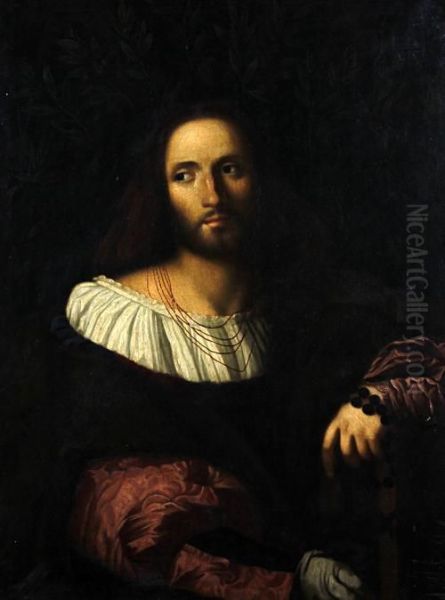
Palma Vecchio occupies a crucial position in the history of Venetian Renaissance painting. He served as a vital link, absorbing the lyrical innovations of Giorgione and the early power of Titian, and translating them into a highly appealing and influential style of his own. While perhaps not possessing the revolutionary genius of Giorgione or the enduring, transformative power of Titian, Palma was far more than a mere follower. He perfected certain types of painting, particularly the idyllic sacra conversazione and the sensuous depiction of female beauty, which became hallmarks of the Venetian School.
His immediate influence was significant. His nephew, Palma il Giovane, inherited his name and artistic lineage, though developing his own later style. His student, Bonifazio Veronese, successfully perpetuated Palma's manner through his own large workshop, impacting artists like Andrea Schiavone. Palma's style also resonated with contemporaries like Lorenzo Lotto, another artist with Lombard roots active in Venice, with whom he shared a certain sensitivity in portraiture and color. Artists from Bergamo who worked in Venice, such as Andrea Previtali and Cariani (Giovanni Busi), were also part of this interconnected artistic milieu.
Furthermore, Palma's work influenced artists active in the Venetian mainland territories, such as Paris Bordone (who also worked closely with Titian) and Moretto da Brescia, demonstrating the reach of his reputation beyond the lagoon city. His emphasis on rich color, atmospheric landscapes, and idealized figures contributed significantly to the overall character of Venetian painting, setting it apart from the more drawing-focused traditions of Florence and Rome (disegno versus colorito). He helped solidify the visual language that would be further developed by the next generation of Venetian giants, including Tintoretto and Paolo Veronese.
Conclusion: An Enduring Appeal
Palma Vecchio remains a deeply appealing figure in Renaissance art history. His paintings offer a vision of harmony, beauty, and serenity, rendered with a masterful command of color and light characteristic of the best of the Venetian School. He navigated the complex artistic landscape of early 16th-century Venice with skill, creating a body of work that stands confidently alongside that of his more famous contemporaries. As a master of the sacra conversazione, a celebrated painter of Venetian beauties, and a key transmitter of the Giorgionesque mood, Palma Vecchio secured his place as an indispensable contributor to the glories of the Italian Renaissance. His art continues to charm and captivate viewers with its warmth, richness, and idealized vision of the world.